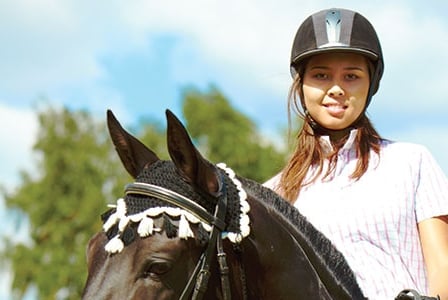
Horseback riding improves posture, core strength and balance; relieves anxiety; and elevates mood.
Although often considered a leisure activity, horseback riding is increasingly being explored as a sport with many health benefits. One hour of riding can burn as many kilojoules as a 30-minute jog. What’s more, horseback riding has been shown to improve mental health, from raising self-esteem to easing stress and improving concentration.
Riding for fitness
Combining the physical benefits of cardio, strength training, Pilates and yoga, horseback riding improves core strength, posture, balance and muscle control—all while toning your legs, bum and core.
Drawn by the ambience—the tree-lined trail and open air fields—horseback riding can be far more appealing than jogging on a treadmill or doing crunches on a gym floor. “Lots of people buy a gym membership and don’t go, but I know very few people who start riding who say, ‘Oh I have to go to the barn’ (grumbling),” says Heather Sansom, riding instructor and personal trainer.
How it works
Core strength and balance
Core muscles are constantly working when riding and are essential for maintaining balance two metres off the ground. “You’re sitting on an object that’s a bit like sitting on a balance ball that’s floating in the air,” says Sansom.
Posture
Maintaining good posture is a must in horseback riding. “Really bad posture is an accident waiting to happen,” warns Sansom. Riders sit tall and relaxed with their shoulders back, allowing for the neutral posture that’s often worked on in Pilates classes. Maintaining good posture on the back of a horse will have you walking taller and straighter on the ground.
Muscle control
Horses are sensitive animals that react to slight muscle shifts. In order to control the horse, riders learn to isolate the muscles needed to lead the horse, while keeping the rest of their body under control. Riders who work at desk jobs and have a tendency to tense their shoulders must learn to relax these muscles; tensing up will hurt the horse, pulling the bit further into its mouth, and affecting the way the horse reacts to the rider.
“You have to be more conscious about controlling your body and your movements so that you’re being kind to your horse in the way that you’re riding,” says Sansom.
Riding for mental health
While providing many fitness benefits, the mental health advantages of the human-horse bond shouldn’t be taken lightly. Equine assisted therapy is often used to build confidence, particularly in children with autism and individuals suffering from depression, and has even proven successful overseas for returned servicemen and women.
Horses demand respect because of their size and strength. “Because you’re on a large horse and you’re bigger than you are on the ground, you feel bigger [and] more capable,” says Sansom. This sense of control and accomplishment helps riders handle difficult situations that arise in their lives.
Randy Hamelin is a psychologist and EAGALA (Equine Assisted Growth and Learning Association) -certified equine therapist who says horses have an innate ability to teach behaviour-control mechanisms.
“The horses mirror the behaviour of people,” says Hamelin. By leading horses through a series of exercises on the ground, individuals can see themselves through the horses’ reactions to their body language and mannerisms and learn to adjust their behaviours, both in the arena and in their daily life, to get their desired results.
Daphne Davey has been a therapeutic riding instructor since 1979 offering therapeutic riding for physically disabled adults and children and individuals suffering from mental health difficulties.
Davey says therapeutic riding has proved particularly useful in treating autism. “The horse doesn’t demand an emotional response,” says Davey, who tells the story of an autistic child who had never said a word to a person but was overheard in the stable talking to his horse. “He felt free enough to be able to talk to the horse, because the horse wasn’t going to turn around and ask him a question that he felt he couldn’t answer,” says Davey.
The human-animal bond isn’t any different from what you would get with a dog or cat, but the added physical benefit provided by riding can also go a long way towards improving one’s mental state. “When you improve your physical condition, you’ll also feel better,” says Davey.
More information
Equine therapy has been found beneficial for children and adults with autism spectrum disorder, bi-polar, ADHD and ADD, Down syndrome, as well as for victims of bullying (and bullies) and abuse victims. For more information about organisations offering therapy, contact
- Australian Equine Facilitated Learning efl.net.au
- Riding for the Disabled rda.org.au
- EAGALA eagala.org/Australasia
Choosing the right stable for you
When looking for a stable, Ritchie recommends the following.
- Survey the cleanliness of the facility; look around the barn and ask yourself if it looks tidy, if the bridles and saddles in the tack room are well-organised and if the horses look healthy.
- Find out if the operator’s instructors, trainers and trail guides are qualified, by checking with Horse Safety Australia horsesafetyaustralia.com.au.
- Ask about class sizes and how much time you will spend on the horse versus in the barn. “If you want to do horseback riding for fitness, you want more time on the horse,” says Ritchie, although barn work is a great workout too! “You can use more muscles than anything you ever (did) in a gym if you work for one week in a barn,” laughs Ritchie.

